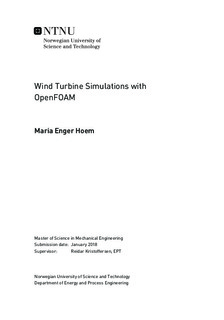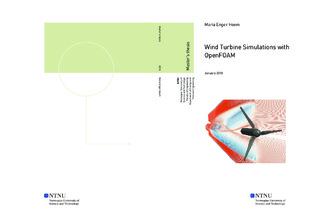| dc.description.abstract | An actuator disk model is improved by including an impermeable hub and nacelle. This improves the wake flow a lot, but it turns out that the actuatorDiskExplicitForce model is mesh dependent.
A mesh is made that provides close to the intended forces and these results are quite good for the wake when using k-ωSST turbulence model. The simulation is compared with real measurements of the simulated wind turbine in a wind tunnel performed at The Norwegian University of Science and Technology.
There are no asymmetric effects on the wake since the turbine tower is not included in the model. The estimated power output is overestimated with an error of 19.59% which is too high, but a very common result it turns out.
After conducting a moving mesh test study which concludes that an Arbitrary Mesh Interface (AMI) can be used without it causing unintended disturbances to the flow, a 3D,transient turbine model is created using AMI.
This report gives a detailed description of how to recreate this model and what to be aware of when doing so. A mesh refinement study is performed to yield the needed refinement of the mesh for the aerodynamic forces on the turbine to be calculated correctly. Due to limited amount of time, the fine mesh is not used, but a coarser mesh is used to test that the model works. With the relatively coarse mesh the estimated power output has an error of 19.27%. The wake is not as resolved as suggested by the mesh study, but the velocity field in the wake is quite well recreated.
The turbulent kinetic energy field in the wake has too low values, but the shape is resembling the measured data. Again, the asymmetric effects in the wake is not reproduced since the turbine tower is not included in the model.
It is concluded that the actuator disk model may be used with care to get a good initial qualitative estimate of flow behavior after the turbine, while the advanced turbine model using AMI gives better estimations for the wake fields and has the potential to estimate turbine performance well. However, the advanced turbine model requires a high performance computer. | |

